MAR015-2: Intercultural Business Management Case Study Analysis
VerifiedAdded on 2023/06/15
|9
|2667
|54
Case Study
AI Summary
This case study delves into intercultural business management, highlighting the importance of understanding cultural practices in multinational organizations. It analyzes a scenario involving a U.S. software company and a Lebanese industrialist, revealing how cultural differences can lead to business challenges. The study identifies problems in cross-cultural management, such as communication barriers, workplace etiquettes, organizational hierarchy, and perception gaps. It compares management behaviors in American and Lebanese organizational cultures using Hofstede's cultural dimensions, including power distance, uncertainty avoidance, individualism vs. collectivism, masculinity vs. femininity, long-term vs. short-term orientation, and indulgence vs. restraint. The report concludes by emphasizing the significance of intercultural understanding in international business and proposing solutions for effective cross-cultural management.

Intercultural business
management
management
Paraphrase This Document
Need a fresh take? Get an instant paraphrase of this document with our AI Paraphraser
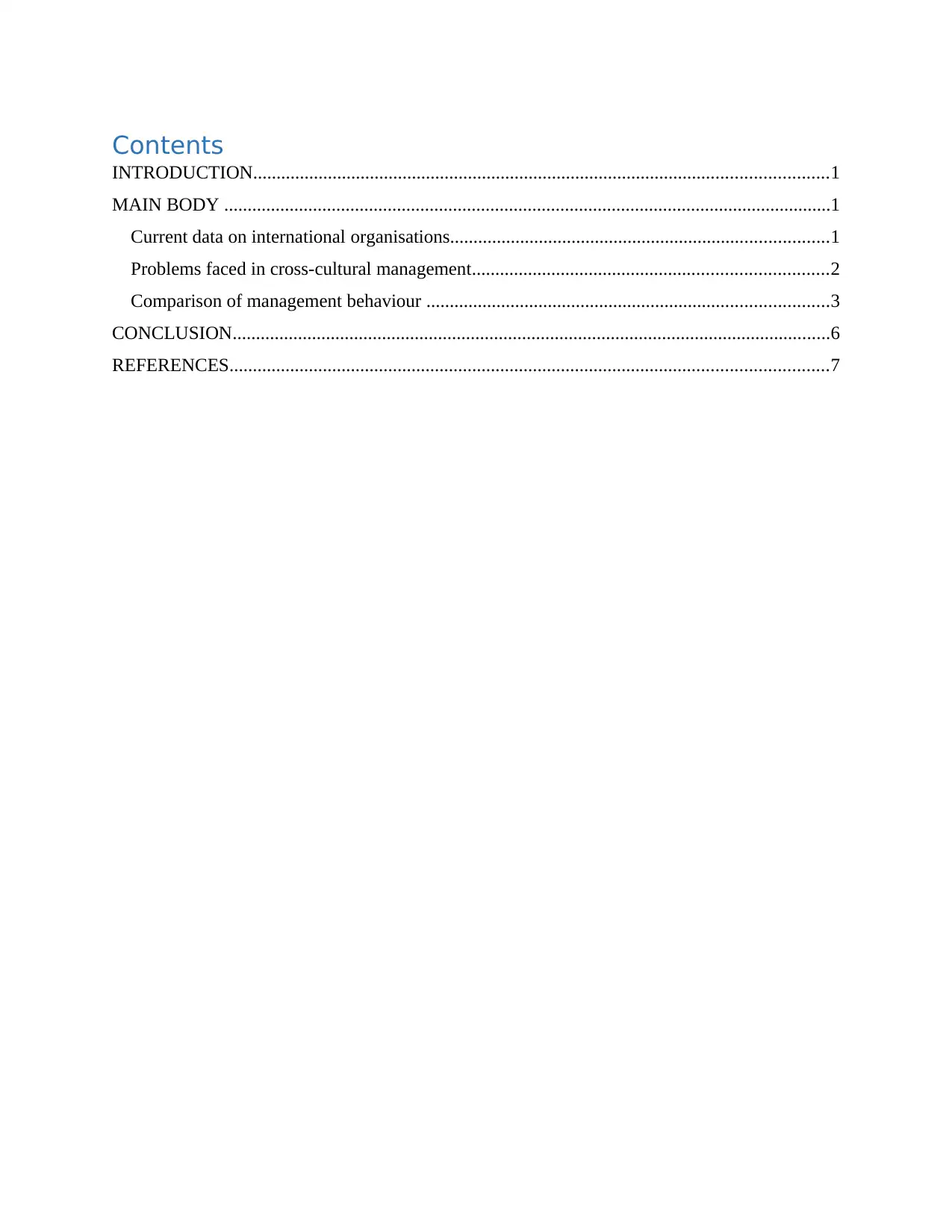
Contents
INTRODUCTION...........................................................................................................................1
MAIN BODY ..................................................................................................................................1
Current data on international organisations.................................................................................1
Problems faced in cross-cultural management............................................................................2
Comparison of management behaviour ......................................................................................3
CONCLUSION................................................................................................................................6
REFERENCES................................................................................................................................7
INTRODUCTION...........................................................................................................................1
MAIN BODY ..................................................................................................................................1
Current data on international organisations.................................................................................1
Problems faced in cross-cultural management............................................................................2
Comparison of management behaviour ......................................................................................3
CONCLUSION................................................................................................................................6
REFERENCES................................................................................................................................7
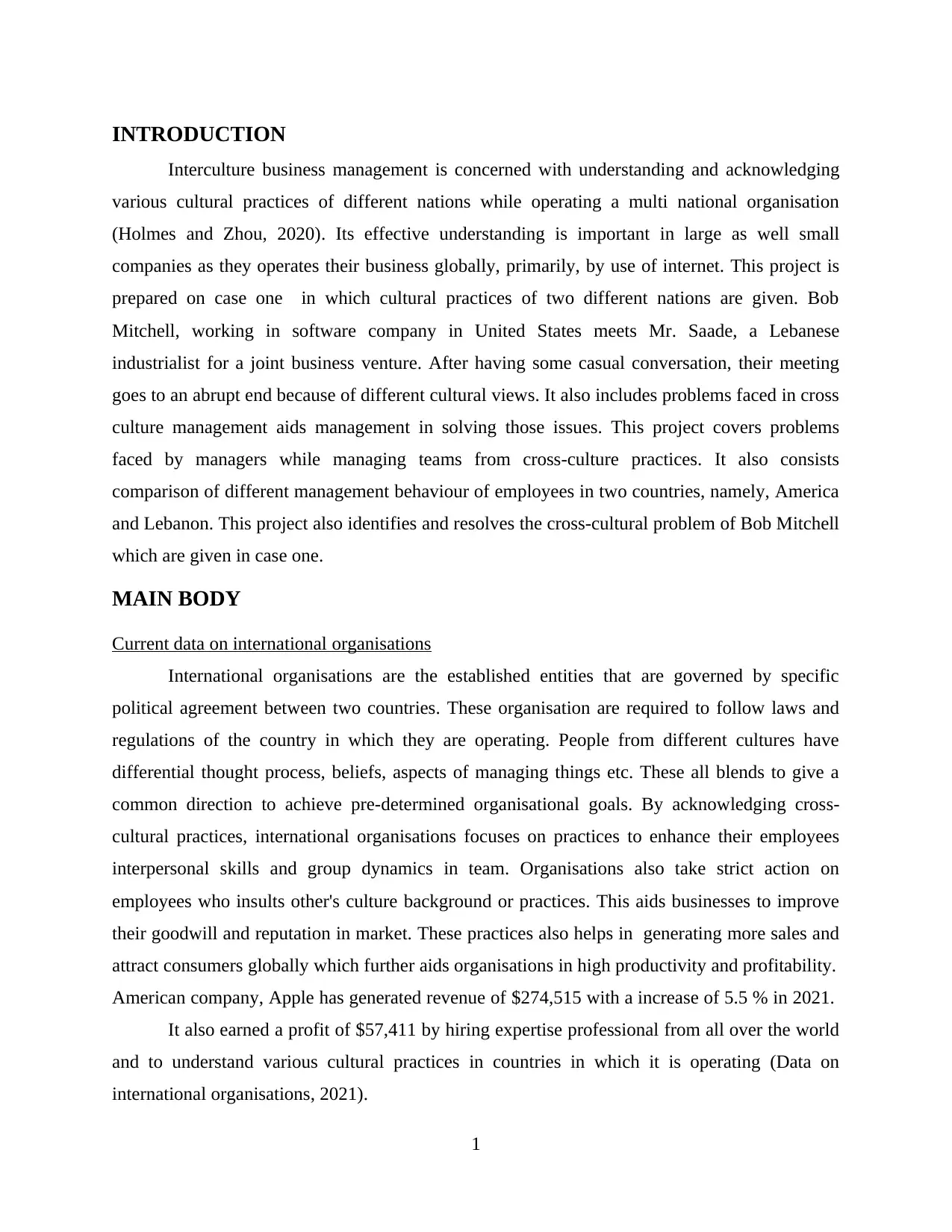
INTRODUCTION
Interculture business management is concerned with understanding and acknowledging
various cultural practices of different nations while operating a multi national organisation
(Holmes and Zhou, 2020). Its effective understanding is important in large as well small
companies as they operates their business globally, primarily, by use of internet. This project is
prepared on case one in which cultural practices of two different nations are given. Bob
Mitchell, working in software company in United States meets Mr. Saade, a Lebanese
industrialist for a joint business venture. After having some casual conversation, their meeting
goes to an abrupt end because of different cultural views. It also includes problems faced in cross
culture management aids management in solving those issues. This project covers problems
faced by managers while managing teams from cross-culture practices. It also consists
comparison of different management behaviour of employees in two countries, namely, America
and Lebanon. This project also identifies and resolves the cross-cultural problem of Bob Mitchell
which are given in case one.
MAIN BODY
Current data on international organisations
International organisations are the established entities that are governed by specific
political agreement between two countries. These organisation are required to follow laws and
regulations of the country in which they are operating. People from different cultures have
differential thought process, beliefs, aspects of managing things etc. These all blends to give a
common direction to achieve pre-determined organisational goals. By acknowledging cross-
cultural practices, international organisations focuses on practices to enhance their employees
interpersonal skills and group dynamics in team. Organisations also take strict action on
employees who insults other's culture background or practices. This aids businesses to improve
their goodwill and reputation in market. These practices also helps in generating more sales and
attract consumers globally which further aids organisations in high productivity and profitability.
American company, Apple has generated revenue of $274,515 with a increase of 5.5 % in 2021.
It also earned a profit of $57,411 by hiring expertise professional from all over the world
and to understand various cultural practices in countries in which it is operating (Data on
international organisations, 2021).
1
Interculture business management is concerned with understanding and acknowledging
various cultural practices of different nations while operating a multi national organisation
(Holmes and Zhou, 2020). Its effective understanding is important in large as well small
companies as they operates their business globally, primarily, by use of internet. This project is
prepared on case one in which cultural practices of two different nations are given. Bob
Mitchell, working in software company in United States meets Mr. Saade, a Lebanese
industrialist for a joint business venture. After having some casual conversation, their meeting
goes to an abrupt end because of different cultural views. It also includes problems faced in cross
culture management aids management in solving those issues. This project covers problems
faced by managers while managing teams from cross-culture practices. It also consists
comparison of different management behaviour of employees in two countries, namely, America
and Lebanon. This project also identifies and resolves the cross-cultural problem of Bob Mitchell
which are given in case one.
MAIN BODY
Current data on international organisations
International organisations are the established entities that are governed by specific
political agreement between two countries. These organisation are required to follow laws and
regulations of the country in which they are operating. People from different cultures have
differential thought process, beliefs, aspects of managing things etc. These all blends to give a
common direction to achieve pre-determined organisational goals. By acknowledging cross-
cultural practices, international organisations focuses on practices to enhance their employees
interpersonal skills and group dynamics in team. Organisations also take strict action on
employees who insults other's culture background or practices. This aids businesses to improve
their goodwill and reputation in market. These practices also helps in generating more sales and
attract consumers globally which further aids organisations in high productivity and profitability.
American company, Apple has generated revenue of $274,515 with a increase of 5.5 % in 2021.
It also earned a profit of $57,411 by hiring expertise professional from all over the world
and to understand various cultural practices in countries in which it is operating (Data on
international organisations, 2021).
1
⊘ This is a preview!⊘
Do you want full access?
Subscribe today to unlock all pages.

Trusted by 1+ million students worldwide
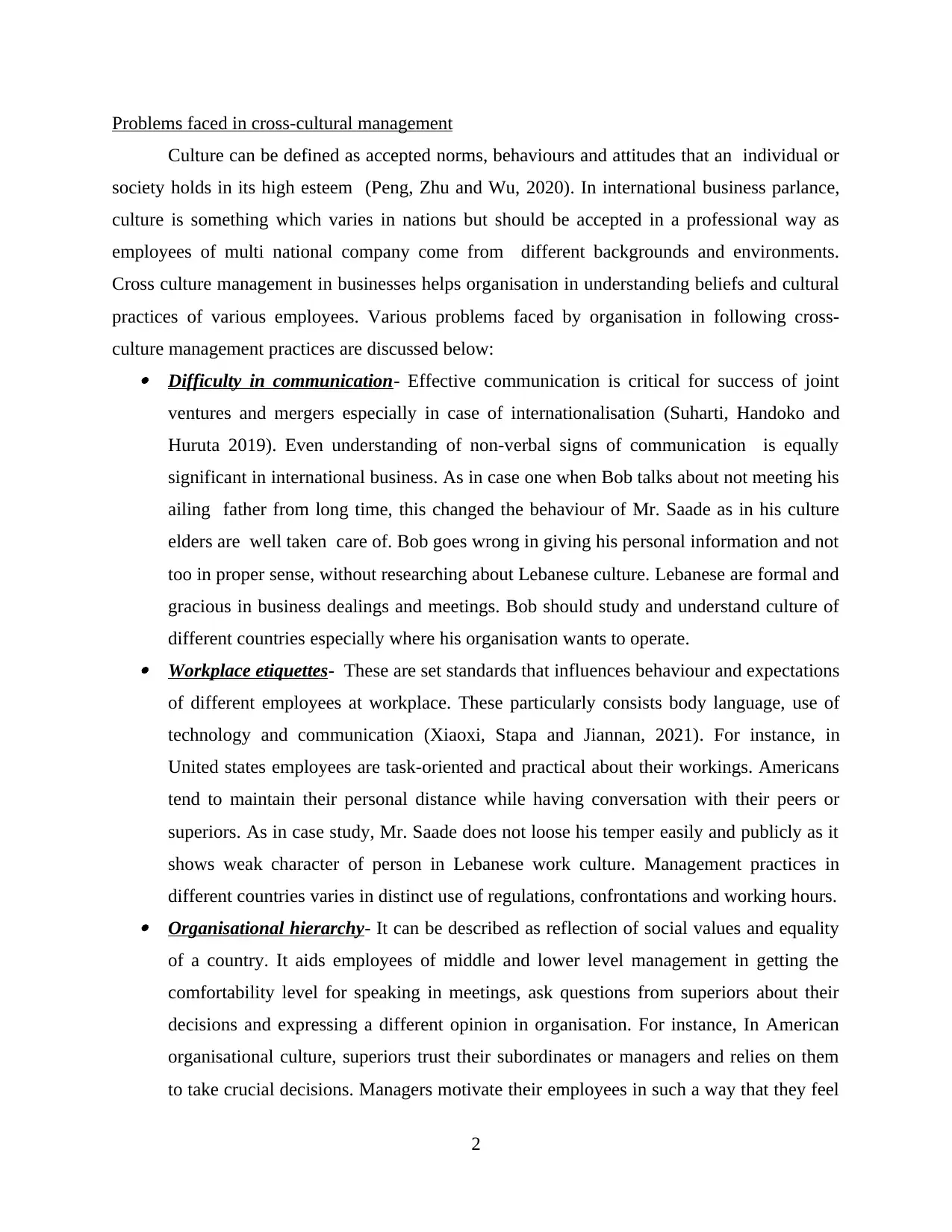
Problems faced in cross-cultural management
Culture can be defined as accepted norms, behaviours and attitudes that an individual or
society holds in its high esteem (Peng, Zhu and Wu, 2020). In international business parlance,
culture is something which varies in nations but should be accepted in a professional way as
employees of multi national company come from different backgrounds and environments.
Cross culture management in businesses helps organisation in understanding beliefs and cultural
practices of various employees. Various problems faced by organisation in following cross-
culture management practices are discussed below: Difficulty in communication- Effective communication is critical for success of joint
ventures and mergers especially in case of internationalisation (Suharti, Handoko and
Huruta 2019). Even understanding of non-verbal signs of communication is equally
significant in international business. As in case one when Bob talks about not meeting his
ailing father from long time, this changed the behaviour of Mr. Saade as in his culture
elders are well taken care of. Bob goes wrong in giving his personal information and not
too in proper sense, without researching about Lebanese culture. Lebanese are formal and
gracious in business dealings and meetings. Bob should study and understand culture of
different countries especially where his organisation wants to operate. Workplace etiquettes- These are set standards that influences behaviour and expectations
of different employees at workplace. These particularly consists body language, use of
technology and communication (Xiaoxi, Stapa and Jiannan, 2021). For instance, in
United states employees are task-oriented and practical about their workings. Americans
tend to maintain their personal distance while having conversation with their peers or
superiors. As in case study, Mr. Saade does not loose his temper easily and publicly as it
shows weak character of person in Lebanese work culture. Management practices in
different countries varies in distinct use of regulations, confrontations and working hours. Organisational hierarchy- It can be described as reflection of social values and equality
of a country. It aids employees of middle and lower level management in getting the
comfortability level for speaking in meetings, ask questions from superiors about their
decisions and expressing a different opinion in organisation. For instance, In American
organisational culture, superiors trust their subordinates or managers and relies on them
to take crucial decisions. Managers motivate their employees in such a way that they feel
2
Culture can be defined as accepted norms, behaviours and attitudes that an individual or
society holds in its high esteem (Peng, Zhu and Wu, 2020). In international business parlance,
culture is something which varies in nations but should be accepted in a professional way as
employees of multi national company come from different backgrounds and environments.
Cross culture management in businesses helps organisation in understanding beliefs and cultural
practices of various employees. Various problems faced by organisation in following cross-
culture management practices are discussed below: Difficulty in communication- Effective communication is critical for success of joint
ventures and mergers especially in case of internationalisation (Suharti, Handoko and
Huruta 2019). Even understanding of non-verbal signs of communication is equally
significant in international business. As in case one when Bob talks about not meeting his
ailing father from long time, this changed the behaviour of Mr. Saade as in his culture
elders are well taken care of. Bob goes wrong in giving his personal information and not
too in proper sense, without researching about Lebanese culture. Lebanese are formal and
gracious in business dealings and meetings. Bob should study and understand culture of
different countries especially where his organisation wants to operate. Workplace etiquettes- These are set standards that influences behaviour and expectations
of different employees at workplace. These particularly consists body language, use of
technology and communication (Xiaoxi, Stapa and Jiannan, 2021). For instance, in
United states employees are task-oriented and practical about their workings. Americans
tend to maintain their personal distance while having conversation with their peers or
superiors. As in case study, Mr. Saade does not loose his temper easily and publicly as it
shows weak character of person in Lebanese work culture. Management practices in
different countries varies in distinct use of regulations, confrontations and working hours. Organisational hierarchy- It can be described as reflection of social values and equality
of a country. It aids employees of middle and lower level management in getting the
comfortability level for speaking in meetings, ask questions from superiors about their
decisions and expressing a different opinion in organisation. For instance, In American
organisational culture, superiors trust their subordinates or managers and relies on them
to take crucial decisions. Managers motivate their employees in such a way that they feel
2
Paraphrase This Document
Need a fresh take? Get an instant paraphrase of this document with our AI Paraphraser
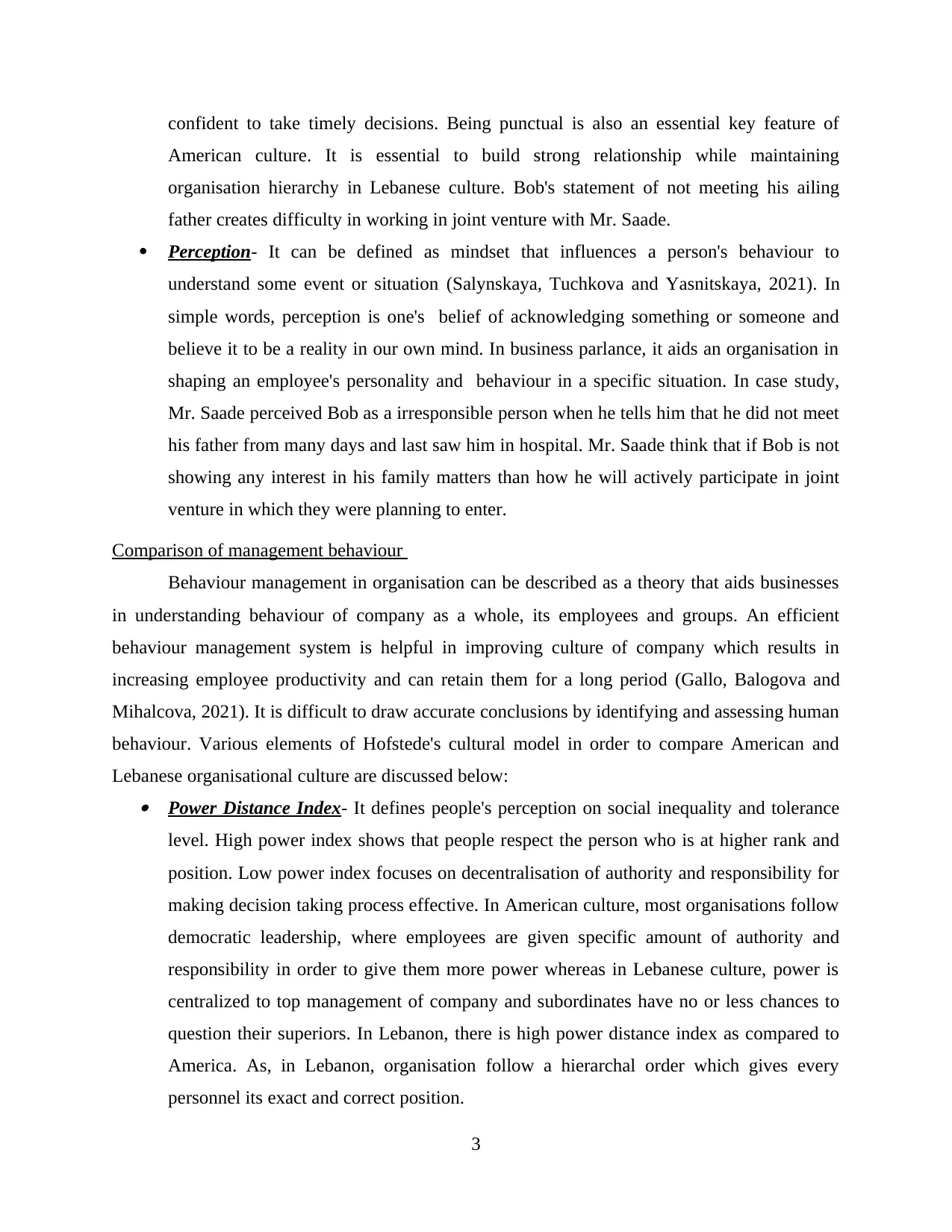
confident to take timely decisions. Being punctual is also an essential key feature of
American culture. It is essential to build strong relationship while maintaining
organisation hierarchy in Lebanese culture. Bob's statement of not meeting his ailing
father creates difficulty in working in joint venture with Mr. Saade.
Perception- It can be defined as mindset that influences a person's behaviour to
understand some event or situation (Salynskaya, Tuchkova and Yasnitskaya, 2021). In
simple words, perception is one's belief of acknowledging something or someone and
believe it to be a reality in our own mind. In business parlance, it aids an organisation in
shaping an employee's personality and behaviour in a specific situation. In case study,
Mr. Saade perceived Bob as a irresponsible person when he tells him that he did not meet
his father from many days and last saw him in hospital. Mr. Saade think that if Bob is not
showing any interest in his family matters than how he will actively participate in joint
venture in which they were planning to enter.
Comparison of management behaviour
Behaviour management in organisation can be described as a theory that aids businesses
in understanding behaviour of company as a whole, its employees and groups. An efficient
behaviour management system is helpful in improving culture of company which results in
increasing employee productivity and can retain them for a long period (Gallo, Balogova and
Mihalcova, 2021). It is difficult to draw accurate conclusions by identifying and assessing human
behaviour. Various elements of Hofstede's cultural model in order to compare American and
Lebanese organisational culture are discussed below: Power Distance Index- It defines people's perception on social inequality and tolerance
level. High power index shows that people respect the person who is at higher rank and
position. Low power index focuses on decentralisation of authority and responsibility for
making decision taking process effective. In American culture, most organisations follow
democratic leadership, where employees are given specific amount of authority and
responsibility in order to give them more power whereas in Lebanese culture, power is
centralized to top management of company and subordinates have no or less chances to
question their superiors. In Lebanon, there is high power distance index as compared to
America. As, in Lebanon, organisation follow a hierarchal order which gives every
personnel its exact and correct position.
3
American culture. It is essential to build strong relationship while maintaining
organisation hierarchy in Lebanese culture. Bob's statement of not meeting his ailing
father creates difficulty in working in joint venture with Mr. Saade.
Perception- It can be defined as mindset that influences a person's behaviour to
understand some event or situation (Salynskaya, Tuchkova and Yasnitskaya, 2021). In
simple words, perception is one's belief of acknowledging something or someone and
believe it to be a reality in our own mind. In business parlance, it aids an organisation in
shaping an employee's personality and behaviour in a specific situation. In case study,
Mr. Saade perceived Bob as a irresponsible person when he tells him that he did not meet
his father from many days and last saw him in hospital. Mr. Saade think that if Bob is not
showing any interest in his family matters than how he will actively participate in joint
venture in which they were planning to enter.
Comparison of management behaviour
Behaviour management in organisation can be described as a theory that aids businesses
in understanding behaviour of company as a whole, its employees and groups. An efficient
behaviour management system is helpful in improving culture of company which results in
increasing employee productivity and can retain them for a long period (Gallo, Balogova and
Mihalcova, 2021). It is difficult to draw accurate conclusions by identifying and assessing human
behaviour. Various elements of Hofstede's cultural model in order to compare American and
Lebanese organisational culture are discussed below: Power Distance Index- It defines people's perception on social inequality and tolerance
level. High power index shows that people respect the person who is at higher rank and
position. Low power index focuses on decentralisation of authority and responsibility for
making decision taking process effective. In American culture, most organisations follow
democratic leadership, where employees are given specific amount of authority and
responsibility in order to give them more power whereas in Lebanese culture, power is
centralized to top management of company and subordinates have no or less chances to
question their superiors. In Lebanon, there is high power distance index as compared to
America. As, in Lebanon, organisation follow a hierarchal order which gives every
personnel its exact and correct position.
3
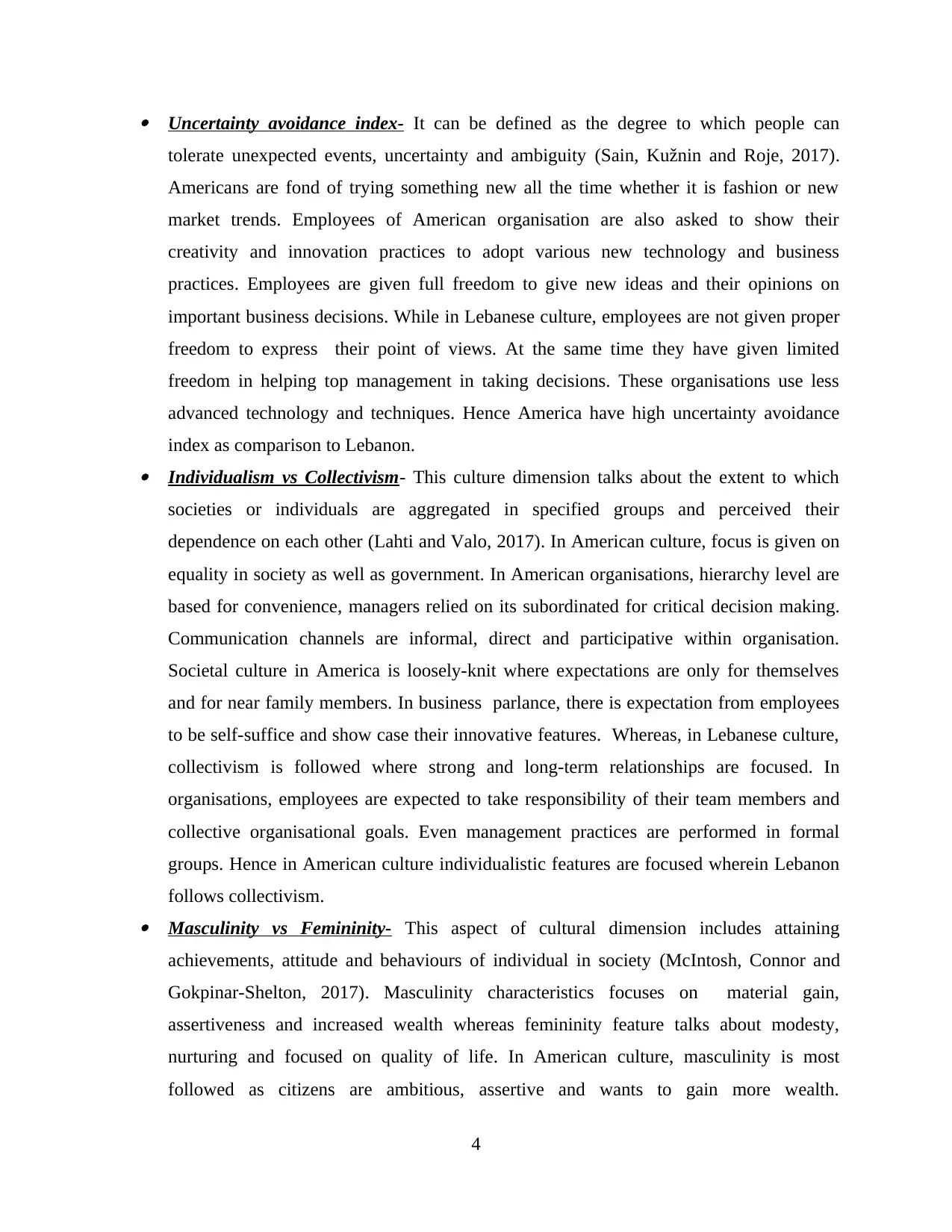
Uncertainty avoidance index- It can be defined as the degree to which people can
tolerate unexpected events, uncertainty and ambiguity (Sain, Kužnin and Roje, 2017).
Americans are fond of trying something new all the time whether it is fashion or new
market trends. Employees of American organisation are also asked to show their
creativity and innovation practices to adopt various new technology and business
practices. Employees are given full freedom to give new ideas and their opinions on
important business decisions. While in Lebanese culture, employees are not given proper
freedom to express their point of views. At the same time they have given limited
freedom in helping top management in taking decisions. These organisations use less
advanced technology and techniques. Hence America have high uncertainty avoidance
index as comparison to Lebanon. Individualism vs Collectivism- This culture dimension talks about the extent to which
societies or individuals are aggregated in specified groups and perceived their
dependence on each other (Lahti and Valo, 2017). In American culture, focus is given on
equality in society as well as government. In American organisations, hierarchy level are
based for convenience, managers relied on its subordinated for critical decision making.
Communication channels are informal, direct and participative within organisation.
Societal culture in America is loosely-knit where expectations are only for themselves
and for near family members. In business parlance, there is expectation from employees
to be self-suffice and show case their innovative features. Whereas, in Lebanese culture,
collectivism is followed where strong and long-term relationships are focused. In
organisations, employees are expected to take responsibility of their team members and
collective organisational goals. Even management practices are performed in formal
groups. Hence in American culture individualistic features are focused wherein Lebanon
follows collectivism. Masculinity vs Femininity- This aspect of cultural dimension includes attaining
achievements, attitude and behaviours of individual in society (McIntosh, Connor and
Gokpinar-Shelton, 2017). Masculinity characteristics focuses on material gain,
assertiveness and increased wealth whereas femininity feature talks about modesty,
nurturing and focused on quality of life. In American culture, masculinity is most
followed as citizens are ambitious, assertive and wants to gain more wealth.
4
tolerate unexpected events, uncertainty and ambiguity (Sain, Kužnin and Roje, 2017).
Americans are fond of trying something new all the time whether it is fashion or new
market trends. Employees of American organisation are also asked to show their
creativity and innovation practices to adopt various new technology and business
practices. Employees are given full freedom to give new ideas and their opinions on
important business decisions. While in Lebanese culture, employees are not given proper
freedom to express their point of views. At the same time they have given limited
freedom in helping top management in taking decisions. These organisations use less
advanced technology and techniques. Hence America have high uncertainty avoidance
index as comparison to Lebanon. Individualism vs Collectivism- This culture dimension talks about the extent to which
societies or individuals are aggregated in specified groups and perceived their
dependence on each other (Lahti and Valo, 2017). In American culture, focus is given on
equality in society as well as government. In American organisations, hierarchy level are
based for convenience, managers relied on its subordinated for critical decision making.
Communication channels are informal, direct and participative within organisation.
Societal culture in America is loosely-knit where expectations are only for themselves
and for near family members. In business parlance, there is expectation from employees
to be self-suffice and show case their innovative features. Whereas, in Lebanese culture,
collectivism is followed where strong and long-term relationships are focused. In
organisations, employees are expected to take responsibility of their team members and
collective organisational goals. Even management practices are performed in formal
groups. Hence in American culture individualistic features are focused wherein Lebanon
follows collectivism. Masculinity vs Femininity- This aspect of cultural dimension includes attaining
achievements, attitude and behaviours of individual in society (McIntosh, Connor and
Gokpinar-Shelton, 2017). Masculinity characteristics focuses on material gain,
assertiveness and increased wealth whereas femininity feature talks about modesty,
nurturing and focused on quality of life. In American culture, masculinity is most
followed as citizens are ambitious, assertive and wants to gain more wealth.
4
⊘ This is a preview!⊘
Do you want full access?
Subscribe today to unlock all pages.

Trusted by 1+ million students worldwide
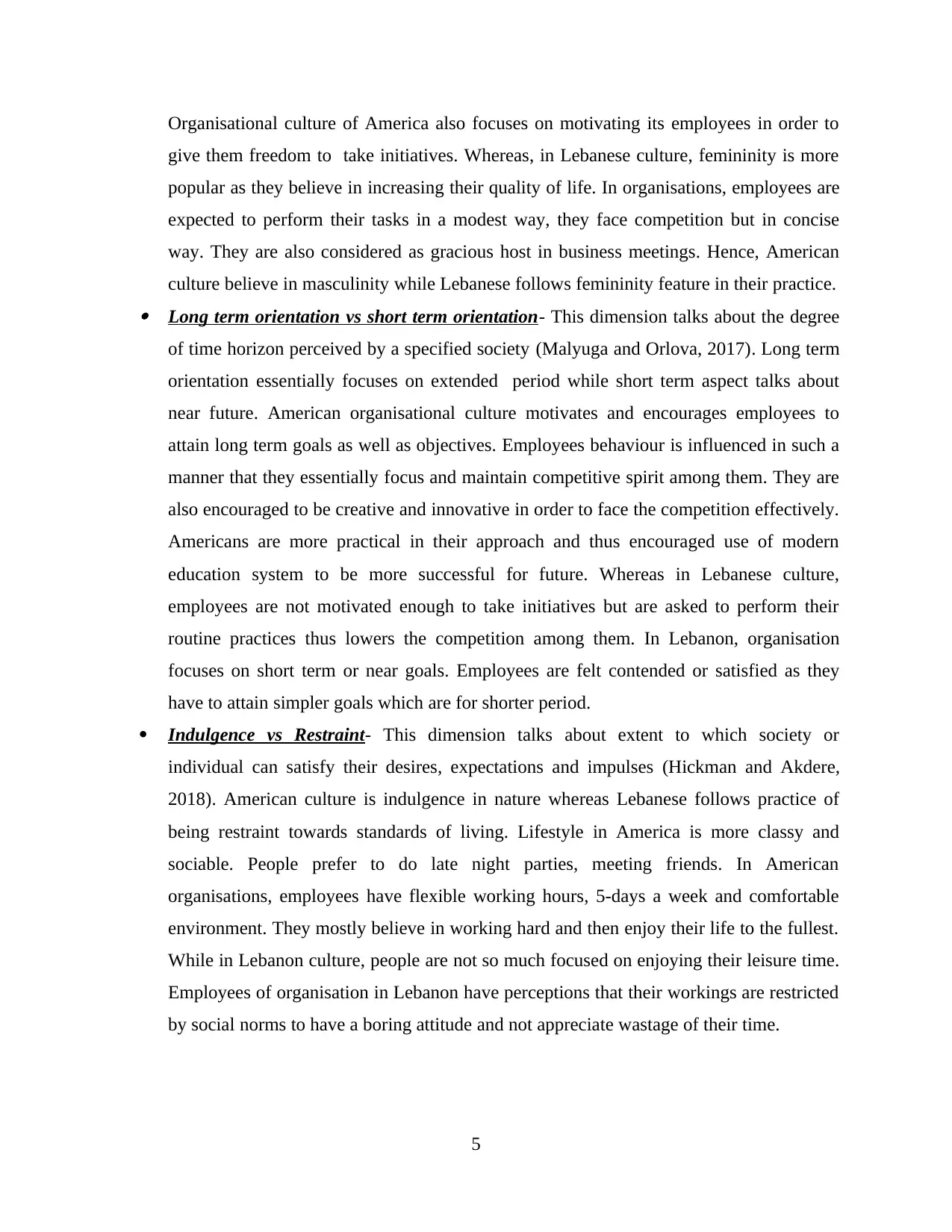
Organisational culture of America also focuses on motivating its employees in order to
give them freedom to take initiatives. Whereas, in Lebanese culture, femininity is more
popular as they believe in increasing their quality of life. In organisations, employees are
expected to perform their tasks in a modest way, they face competition but in concise
way. They are also considered as gracious host in business meetings. Hence, American
culture believe in masculinity while Lebanese follows femininity feature in their practice. Long term orientation vs short term orientation- This dimension talks about the degree
of time horizon perceived by a specified society (Malyuga and Orlova, 2017). Long term
orientation essentially focuses on extended period while short term aspect talks about
near future. American organisational culture motivates and encourages employees to
attain long term goals as well as objectives. Employees behaviour is influenced in such a
manner that they essentially focus and maintain competitive spirit among them. They are
also encouraged to be creative and innovative in order to face the competition effectively.
Americans are more practical in their approach and thus encouraged use of modern
education system to be more successful for future. Whereas in Lebanese culture,
employees are not motivated enough to take initiatives but are asked to perform their
routine practices thus lowers the competition among them. In Lebanon, organisation
focuses on short term or near goals. Employees are felt contended or satisfied as they
have to attain simpler goals which are for shorter period.
Indulgence vs Restraint- This dimension talks about extent to which society or
individual can satisfy their desires, expectations and impulses (Hickman and Akdere,
2018). American culture is indulgence in nature whereas Lebanese follows practice of
being restraint towards standards of living. Lifestyle in America is more classy and
sociable. People prefer to do late night parties, meeting friends. In American
organisations, employees have flexible working hours, 5-days a week and comfortable
environment. They mostly believe in working hard and then enjoy their life to the fullest.
While in Lebanon culture, people are not so much focused on enjoying their leisure time.
Employees of organisation in Lebanon have perceptions that their workings are restricted
by social norms to have a boring attitude and not appreciate wastage of their time.
5
give them freedom to take initiatives. Whereas, in Lebanese culture, femininity is more
popular as they believe in increasing their quality of life. In organisations, employees are
expected to perform their tasks in a modest way, they face competition but in concise
way. They are also considered as gracious host in business meetings. Hence, American
culture believe in masculinity while Lebanese follows femininity feature in their practice. Long term orientation vs short term orientation- This dimension talks about the degree
of time horizon perceived by a specified society (Malyuga and Orlova, 2017). Long term
orientation essentially focuses on extended period while short term aspect talks about
near future. American organisational culture motivates and encourages employees to
attain long term goals as well as objectives. Employees behaviour is influenced in such a
manner that they essentially focus and maintain competitive spirit among them. They are
also encouraged to be creative and innovative in order to face the competition effectively.
Americans are more practical in their approach and thus encouraged use of modern
education system to be more successful for future. Whereas in Lebanese culture,
employees are not motivated enough to take initiatives but are asked to perform their
routine practices thus lowers the competition among them. In Lebanon, organisation
focuses on short term or near goals. Employees are felt contended or satisfied as they
have to attain simpler goals which are for shorter period.
Indulgence vs Restraint- This dimension talks about extent to which society or
individual can satisfy their desires, expectations and impulses (Hickman and Akdere,
2018). American culture is indulgence in nature whereas Lebanese follows practice of
being restraint towards standards of living. Lifestyle in America is more classy and
sociable. People prefer to do late night parties, meeting friends. In American
organisations, employees have flexible working hours, 5-days a week and comfortable
environment. They mostly believe in working hard and then enjoy their life to the fullest.
While in Lebanon culture, people are not so much focused on enjoying their leisure time.
Employees of organisation in Lebanon have perceptions that their workings are restricted
by social norms to have a boring attitude and not appreciate wastage of their time.
5
Paraphrase This Document
Need a fresh take? Get an instant paraphrase of this document with our AI Paraphraser
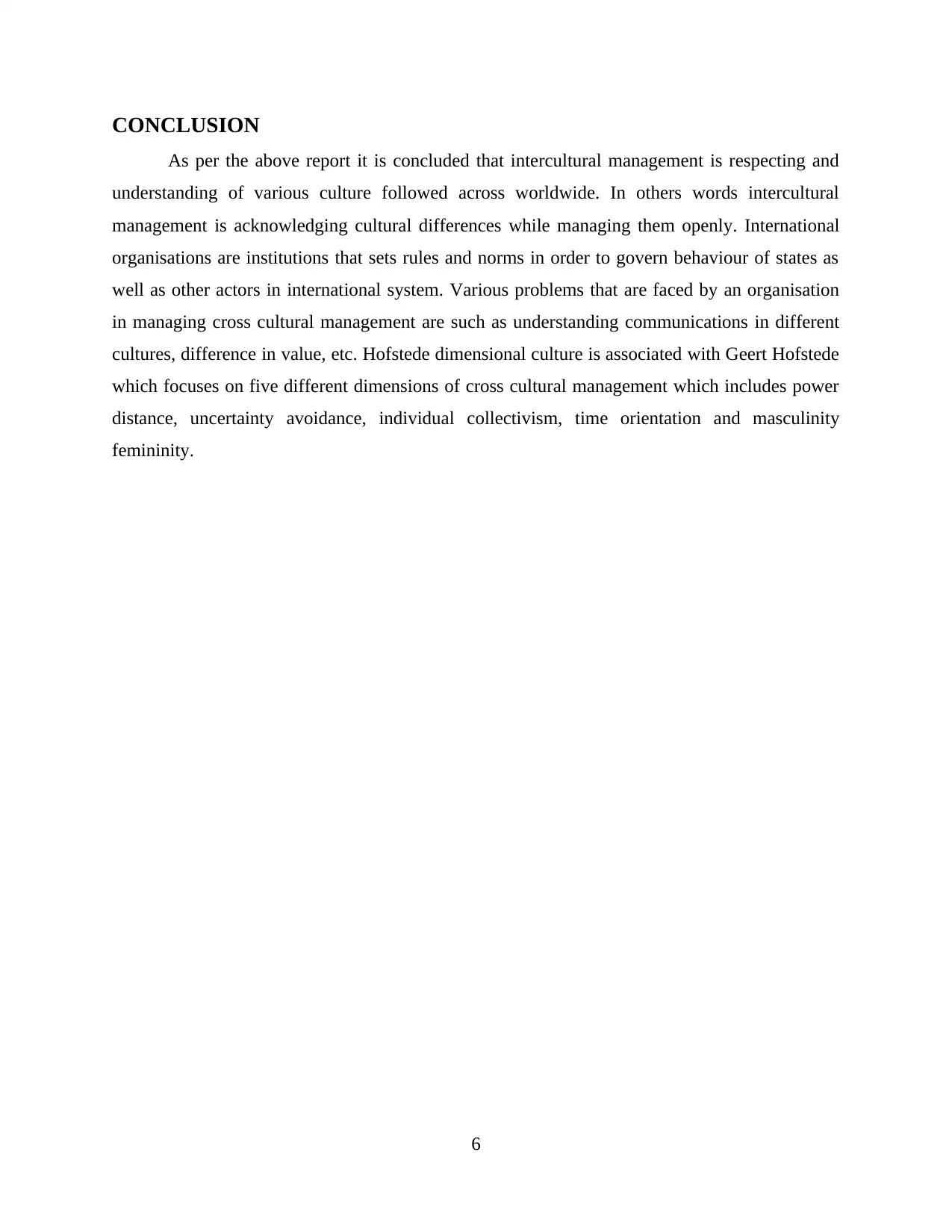
CONCLUSION
As per the above report it is concluded that intercultural management is respecting and
understanding of various culture followed across worldwide. In others words intercultural
management is acknowledging cultural differences while managing them openly. International
organisations are institutions that sets rules and norms in order to govern behaviour of states as
well as other actors in international system. Various problems that are faced by an organisation
in managing cross cultural management are such as understanding communications in different
cultures, difference in value, etc. Hofstede dimensional culture is associated with Geert Hofstede
which focuses on five different dimensions of cross cultural management which includes power
distance, uncertainty avoidance, individual collectivism, time orientation and masculinity
femininity.
6
As per the above report it is concluded that intercultural management is respecting and
understanding of various culture followed across worldwide. In others words intercultural
management is acknowledging cultural differences while managing them openly. International
organisations are institutions that sets rules and norms in order to govern behaviour of states as
well as other actors in international system. Various problems that are faced by an organisation
in managing cross cultural management are such as understanding communications in different
cultures, difference in value, etc. Hofstede dimensional culture is associated with Geert Hofstede
which focuses on five different dimensions of cross cultural management which includes power
distance, uncertainty avoidance, individual collectivism, time orientation and masculinity
femininity.
6

REFERENCES
Books and Journals:
Gallo, P., Balogova, B. and Mihalcova, B., 2021. The Influence of Intercultural Management
Factors as Elements of Management Innovation.
Hickman, L. and Akdere, M., 2018, February. Developing intercultural competencies through
virtual reality: Internet of Things applications in education and learning. In 2018 15th
learning and technology conference (L&T) (pp. 24-28). IEEE.
Holmes, P. and Zhou, V. X., 2020. Intercultural business education: The role of critical theory
and experiential learning. In The Routledge Handbook of Language and Intercultural
Communication (pp. 457-472). Routledge.
Lahti, M. and Valo, M., 2017. Intercultural workplace communication. Oxford Research
Encyclopedia of Communication.
Malyuga, E. N. and Orlova, S. N., 2017. Linguistic pragmatics of intercultural professional and
business communication. Springer.
McIntosh, K., Connor, U. and Gokpinar-Shelton, E., 2017. What intercultural rhetoric can bring
to EAP/ESP writing studies in an English as a lingua franca world. Journal of English
for Academic Purposes. 29. pp.12-20.
Peng, R. Z., Zhu, C. and Wu, W. P., 2020. Visualizing the knowledge domain of intercultural
competence research: A bibliometric analysis. International Journal of Intercultural
Relations. 74. pp.58-68.
Sain, Z. F., Kužnin, M. and Roje, R. C., 2017. Teaching intercultural competence in
undergraduate business and management studies–A case study. Croatian Journal of
Education. 19(1). pp.55-71.
Salynskaya, T. V., Tuchkova, I. G. and Yasnitskaya, A. A., 2021. An Investigation into
Undergraduate Students’ Readiness for Intercultural Written Communication in a
Foreign Language. Journal of Intercultural Communication. 21(2). pp.70-81.
Suharti, L., Handoko, Y. A. and Huruta, A. D., 2019. Linking cultural intelligence and adaptive
performance: do intercultural interactions and Host University Support™ play important
roles?. Business, Management and Economics Engineering. 17(1). pp.36-48.
Xiaoxi, G., Stapa, M. B. and Jiannan, J., 2021. E-COMMUNICATION INSTRUMENTS IN
INTERCULTURAL BUSINESS COMMUNICATION IN MAINLAND
CHINA. Academy of Entrepreneurship Journal. 27. pp.1-10.
Online:
Data on international organisations. 2021. [Online]. Available through:
<https://fortune.com/fortune500/2021/search/>
7
Books and Journals:
Gallo, P., Balogova, B. and Mihalcova, B., 2021. The Influence of Intercultural Management
Factors as Elements of Management Innovation.
Hickman, L. and Akdere, M., 2018, February. Developing intercultural competencies through
virtual reality: Internet of Things applications in education and learning. In 2018 15th
learning and technology conference (L&T) (pp. 24-28). IEEE.
Holmes, P. and Zhou, V. X., 2020. Intercultural business education: The role of critical theory
and experiential learning. In The Routledge Handbook of Language and Intercultural
Communication (pp. 457-472). Routledge.
Lahti, M. and Valo, M., 2017. Intercultural workplace communication. Oxford Research
Encyclopedia of Communication.
Malyuga, E. N. and Orlova, S. N., 2017. Linguistic pragmatics of intercultural professional and
business communication. Springer.
McIntosh, K., Connor, U. and Gokpinar-Shelton, E., 2017. What intercultural rhetoric can bring
to EAP/ESP writing studies in an English as a lingua franca world. Journal of English
for Academic Purposes. 29. pp.12-20.
Peng, R. Z., Zhu, C. and Wu, W. P., 2020. Visualizing the knowledge domain of intercultural
competence research: A bibliometric analysis. International Journal of Intercultural
Relations. 74. pp.58-68.
Sain, Z. F., Kužnin, M. and Roje, R. C., 2017. Teaching intercultural competence in
undergraduate business and management studies–A case study. Croatian Journal of
Education. 19(1). pp.55-71.
Salynskaya, T. V., Tuchkova, I. G. and Yasnitskaya, A. A., 2021. An Investigation into
Undergraduate Students’ Readiness for Intercultural Written Communication in a
Foreign Language. Journal of Intercultural Communication. 21(2). pp.70-81.
Suharti, L., Handoko, Y. A. and Huruta, A. D., 2019. Linking cultural intelligence and adaptive
performance: do intercultural interactions and Host University Support™ play important
roles?. Business, Management and Economics Engineering. 17(1). pp.36-48.
Xiaoxi, G., Stapa, M. B. and Jiannan, J., 2021. E-COMMUNICATION INSTRUMENTS IN
INTERCULTURAL BUSINESS COMMUNICATION IN MAINLAND
CHINA. Academy of Entrepreneurship Journal. 27. pp.1-10.
Online:
Data on international organisations. 2021. [Online]. Available through:
<https://fortune.com/fortune500/2021/search/>
7
⊘ This is a preview!⊘
Do you want full access?
Subscribe today to unlock all pages.

Trusted by 1+ million students worldwide
1 out of 9
Related Documents
Your All-in-One AI-Powered Toolkit for Academic Success.
+13062052269
info@desklib.com
Available 24*7 on WhatsApp / Email
![[object Object]](/_next/static/media/star-bottom.7253800d.svg)
Unlock your academic potential
Copyright © 2020–2025 A2Z Services. All Rights Reserved. Developed and managed by ZUCOL.


